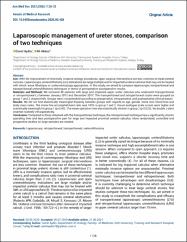Laparoscopic management of ureter stones, comparisonof two techniques
Özet
Aim: With the improvement of minimally invasive urology procedures, open surgical interventions are less common to treat ureteralcalculus. Laparoscopic ureterolithotomy (LU) indications are large multiple and/or impacted ureteral calculus that may not be treatedwith shock-wave lithotripsy or ureterorenoscopy approaches. In this study, we aimed to compare laparoscopic retroperitoneal andtransperitoneal ureterolithotomy techniques in terms of perioperative-postoperative results. Materials and Methods: We reviewed 45 patients with large and impacted upper ureter calculus who underwent transperitonealor retroperitoneal LU between January 2012 and December 2017. The transperitoneal and retroperitoneal routes were grouped asgroup 1 and 2, respectively. Groups were crosschecked according to preoperative, intraoperative, and postoperative clinical datum. Results: We did not find statistically meaningful disparity between groups with regards to age, gender, stone size, blood loss andbody mass index. The stone free accomplishment ratio was 100% in group 1 and 2. Visual analogue scale scores were higher andstatistically meaningful in group 1 (p<0.05). The mean operative time was statistically shorter in group 2 (p:0.022). No double J stentinserted routinely intraoperatively. Conclusion: Compared to those obtained with the transperitoneal technique, the retroperitoneal technique has a significantly shorteroperating time and less postoperative pain for large and impacted proximal ureteral calculus. More randomized, controlled andprospective studies on large samples are needed.
Kaynak
Annals of Medical ResearchCilt
28Sayı
6Bağlantı
https://search.trdizin.gov.tr/yayin/detay/463570/laparoscopic-management-of-ureter-stones-comparisonof-two-techniqueshttps://hdl.handle.net/20.500.12868/2068


















